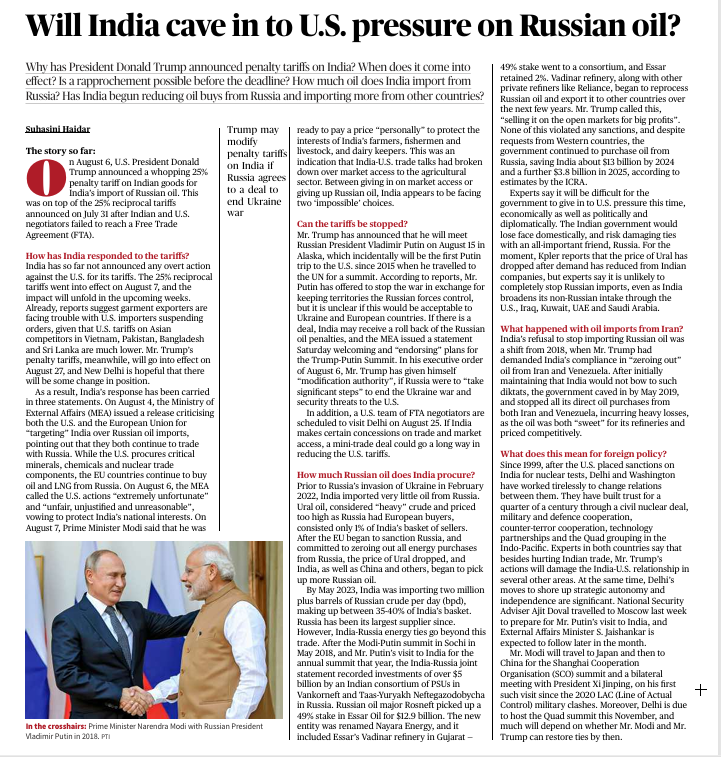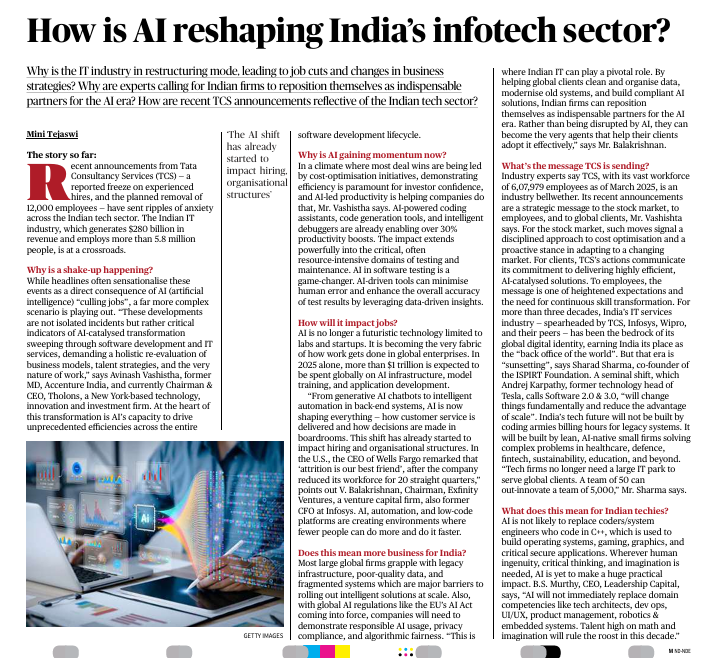Key Points
1. Context
- Aug 6: US announced a 25% penalty tariff on Indian goods over continued imports of Russian oil.
- This is in addition to 25% reciprocal tariffs (effective Aug 7) on Indian exports amid ongoing India–US trade tensions.
- Penalty tariffs will take effect from Aug 27, unless India alters its stance.
2. India’s Response so far
- No retaliatory tariff action yet; hoping for negotiated resolution.
- MEA statements criticised US and EU for “targeting” India while they continue trade with Russia.
- PM Modi reaffirmed commitment to protecting India’s farmers, fishermen, livestock, and dairy keepers.
- Ongoing India–US trade talks aim to reduce differences, possibly in exchange for concessions on Russian imports.
3. US Motives and Pressure Tactics
- President Trump has linked easing of tariffs to a deal ending the Ukraine war.
- US negotiating approach involves using trade tariffs as leverage to extract commitments from India.
- Security concerns tied to Ukraine war and maintaining sanctions pressure on Russia are a core driver.
4. Russia–India Oil Trade
- Post-Ukraine war (2022), India sharply increased Russian oil imports:
- Before war: negligible share in India’s crude basket.
- After war: ~35–40% share.
- Before war: negligible share in India’s crude basket.
- Russian crude sold at a discount compared to other suppliers.
- Indian refiners like Reliance and Nayara Energy reprocess Russian oil and export products to other countries.
- Russian supply allowed India to curb inflation and keep fuel prices stable.
5. Strategic Dilemmas
- Reducing Russian imports would harm India economically and geopolitically, especially when Iranian oil imports remain restricted due to earlier US sanctions.
- India’s ties with Russia are vital for defence procurement, nuclear cooperation, and energy security.
- But India also seeks to avoid further friction with the US — a critical partner in Indo-Pacific strategy.
6. Future Prospects
- Tariff removal or reduction possible if:
- India makes some measured cuts in Russian imports.
- Both sides agree on mutual concessions in trade and security areas.
- India makes some measured cuts in Russian imports.
- Likely that India will diversify crude sources but not fully comply with US demands.
Possible UPSC Mains Questions
GS Paper 2 – International Relations
“Discuss the strategic and economic challenges for India in balancing relations between the US and Russia amid sanctions on Russian oil.”
Key Points – How is AI reshaping India’s Infotech Sector?
1. Context & Trigger
- Recent TCS announcements: Freeze on experienced hires and planned removal of 12,000 employees.
- Reflects AI-driven transformation rather than mere job cuts.
- Indian IT industry: $280 billion revenue, over 5.8 million employees.
2. Why the Shake-up?
- Not isolated layoffs but systemic changes due to:
- AI-led productivity gains.
- Shift in business models & talent strategies.
- Demand for efficiency & cost-optimisation.
- AI-led productivity gains.
- AI’s capacity to drive efficiencies across entire software development lifecycle is central.
3. Why Now?
- Global investors value efficiency and innovation in competitive climate.
- AI tools (code generation, debugging, testing automation) bring:
- 30%+ productivity boosts.
- Faster, more accurate testing.
- Reduced human error in software lifecycle.
- 30%+ productivity boosts.
- AI now seen as non-negotiable in maintaining competitiveness.
4. Impact on Jobs & Organisational Structures
- AI is beyond niche applications – now integral to global enterprises.
- $1 trillion projected global AI infrastructure market by 2025.
- Shifts include:
- Reduced workforce for certain roles.
- Low-code/no-code platforms enabling faster delivery.
- More agile, AI-integrated project cycles.
- Reduced workforce for certain roles.
5. TCS’s Strategy
- Signalling to market: adaptation to change.
- Client value proposition: cost efficiency, agility, legal compliance.
- Positioning as strategic AI partner rather than just a service vendor.
6. Implications for Indian Tech Talent
- IT engineers must upskill for AI-led workflows.
- Demand will grow in:
- Healthcare AI.
- Fintech AI.
- Legal AI solutions.
- Emerging technologies like generative AI.
- Healthcare AI.
- India’s tech future will hinge on scaling AI for global competitiveness.
UPSC Mains Practice Question
GS Paper 3 – Science & Technology / Economy
“Discuss the implications of Artificial Intelligence on India’s IT services sector, with reference to employment patterns, business strategies, and global competitiveness. Suggest measures to harness AI for sustainable industry growth.”



